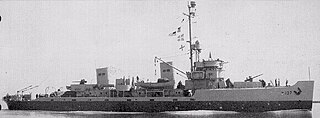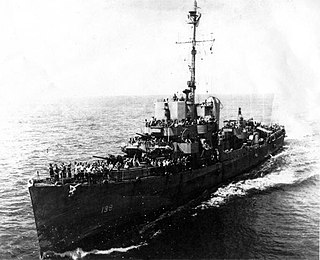
USS Ellyson (DD-454/DMS-19), a Gleaves-class destroyer, is the only ship of the United States Navy to be named for Theodore Gordon Ellyson, a submariner who became the first officer of the U.S. Navy to be designated a naval aviator.

USS Laramie (AO-16) was a Kaweah-class fleet replenishment oiler in the United States Navy.
USS Wheatear (AM-390) was an Auk-class minesweeper acquired by the United States Navy for the dangerous task of removing mines from minefields laid in the water to prevent ships from passing.

USS Prevail (AM-107) was an Auk-class minesweeper acquired by the United States Navy for the dangerous task of removing mines from minefields laid in the water to prevent ships from passing.

USS Cardinal (AM-67) was a Bullfinch-class minesweeper in the United States Navy during World War II.

USS Brant (AM-24) was a Lapwing-class minesweeper in the United States Navy during World War II. She was named by the U.S. Navy for the brant, a small goose.
USS Bullfinch (AM-66) was a Bullfinch-class minesweeper of the United States Navy during World War II.

USS Sandpiper (AM-51) was a Lapwing-class minesweeper. Laid down on 15 November 1918 at the Philadelphia Navy Yard, Philadelphia, Pennsylvania, and launched on 28 April 1919, USS Sandpiper was commissioned on 9 October 1919, redesignated AM-51 on 17 February 1920, and reclassified as a Small Seaplane Tender, AVP-9 on 22 January 1936.
USS Albatross (AM-71) was an Albatross-class minesweeper of the United States Navy during World War II.

USS Linnet (AM-76), was a Kite-class minesweeper of the United States Navy during World War II.
USS Grackle (AM-73) was a minesweeper in the service of the United States Navy during World War II.
USS Kite (AM-75) was the lead ship of her class of minesweepers of the United States Navy during World War II.

USS Farquhar (DE-139) was an Edsall-class destroyer escort in service with the U.S. Navy from 1943 to 1946. She was scrapped in 1974.

USS Jubilant (AM-255) was an Admirable-class minesweeper built for the United States Navy during World War II. She served in the Atlantic during World War II. She was decommissioned in May 1946 and placed in reserve. Although she did not see service in the war zone, Jubilant was recommissioned in May 1951 during the Korean War and remained in commission until April 1954, when she was placed in reserve again. While she remained in reserve, Jubilant was reclassified as MSF-255 in February 1955 but never reactivated. In October 1962, she was sold to the Mexican Navy and renamed ARM DM-01. In 1994 she was renamed ARM General Miguel Negrete (C50). She was stricken in 2000, and sunk as an artificial reef off Veracruz in August 2001.
USS Bluebird (AM-72) was an Albatross-class minesweeper acquired by the U.S. Navy during World War II for clearing minefields during fleet operations.
USS Goldfinch (AM-77) was a minesweeper acquired by the U.S. Navy for the dangerous task of removing mines from minefields laid in the water to prevent ships from passing.

USS Goldfinch (AMS-12/YMS-306) was a YMS-1-class minesweeper of the YMS-135 subclass acquired by the U.S. Navy for the dangerous task of removing mines from minefields laid in the water to prevent ships from passing.
USS Gull (AM-74) was a minesweeper acquired by the U.S. Navy for the dangerous task of removing mines from minefields laid in the water to prevent ships from passing.

USS Matagorda (AVP-22/AG-122) was a United States Navy Barnegat-class seaplane tender in commission from 1941 to 1946 that saw service in World War II. After the war, she was in commission in the United States Coast Guard as the cutter USCGC Matagorda (WAVP-373), later WHEC-373, from 1949 to 1967.

The second USS Barnegat (AVP-10), in commission from 1941 to 1946, was the lead ship of her class of small seaplane tenders built for the United States Navy just before and during World War II. She was the second U.S. Navy ship to bear that name.











